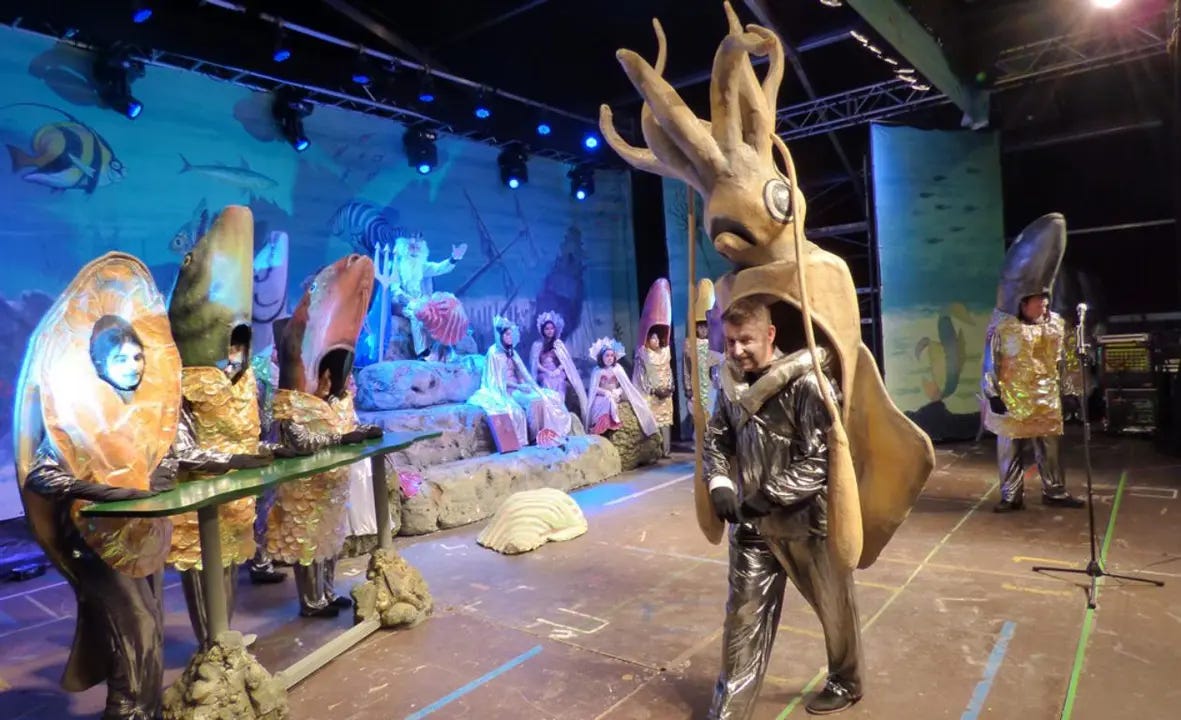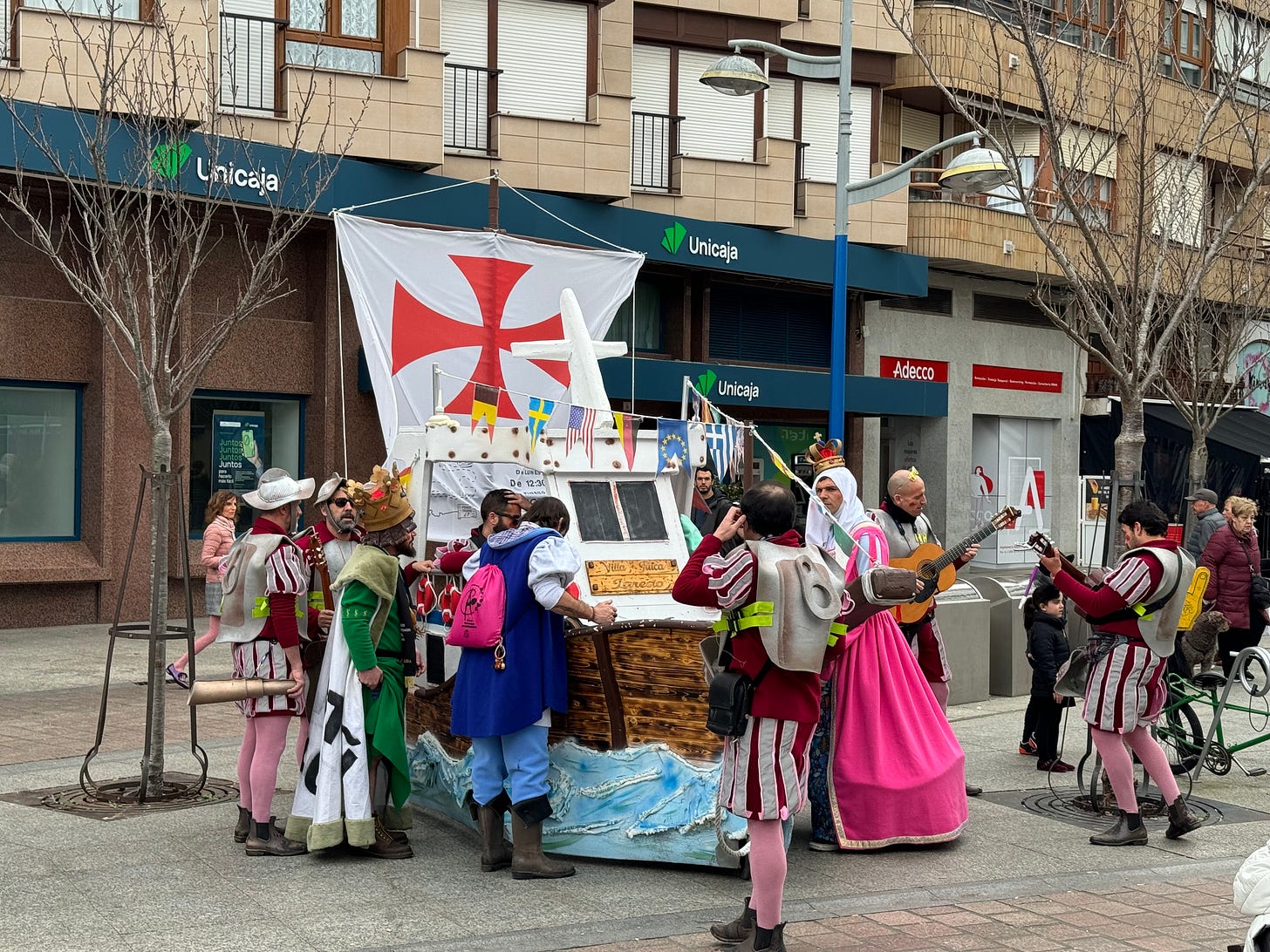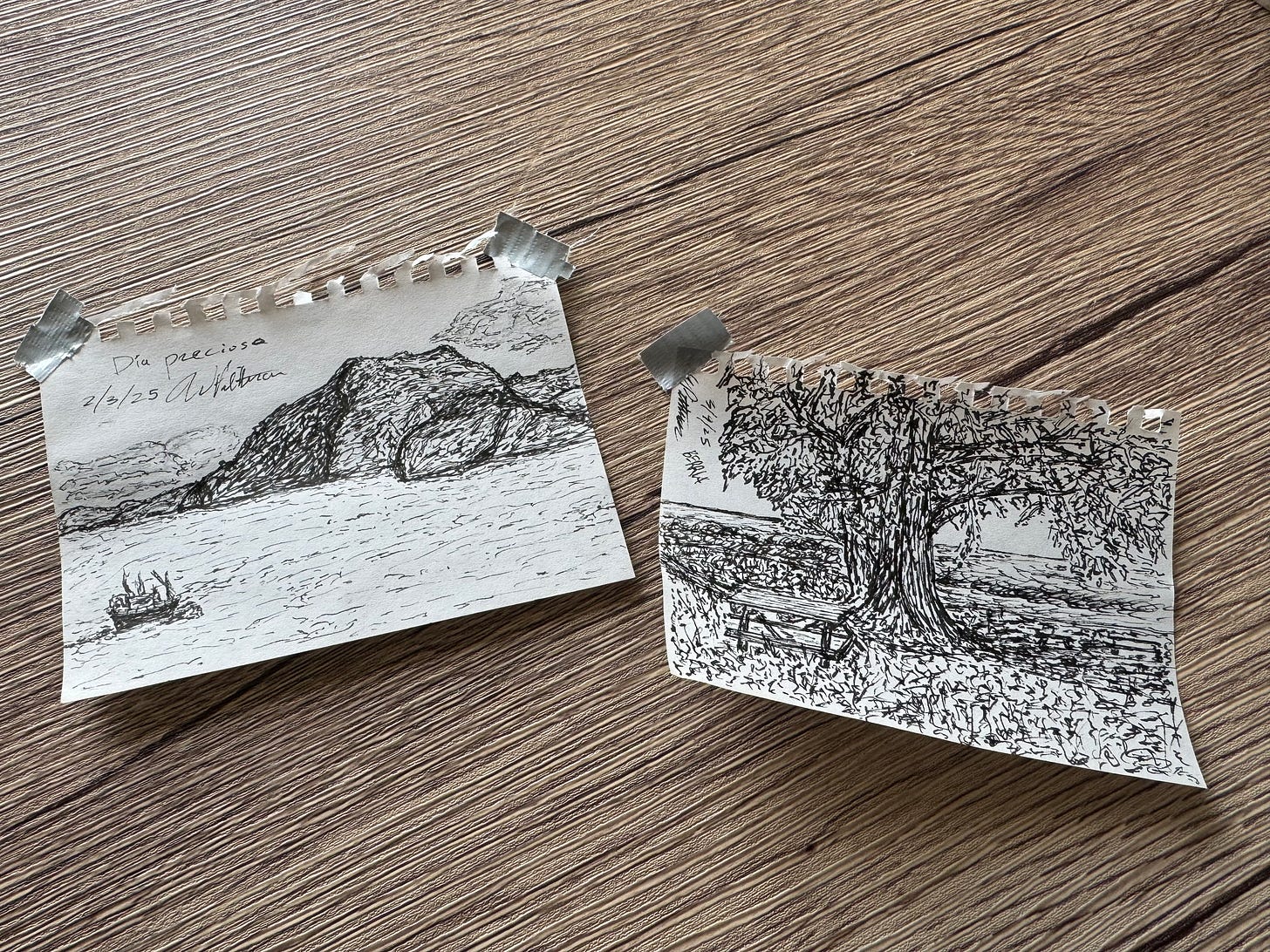Well folks, it finally happened. It was Sunday morning, and I was groggily brushing my teeth when it struck me: I dreamed in Spanish last night. Now, there have been plenty of mornings where I wake up thinking in Spanish, but as far as my memory serves, this was the first time I could recollect actually conversing in Spanish within my dreamscape. The scenario was as follows:
I was at one of my good high school friend’s house, back in Jacksonville. We were upstairs, and his Dad was there with two cleaning ladies who were speaking Spanish.1 As I arrived upstairs, the ladies said something to my friend’s Dad and he said back to them, “No, cuando.” In my dream, I understood he was trying to say he couldn’t speak Spanish, but this actually just translates to “No, when.” I walked into the room where the women were — they were laughing about the phrase — and told them “no tiene sentido” (it doesn’t make sense) and then began talking about how saying “No, cuando,” indicates you are going to say more, follow up on the “when,” in some way. I don’t remember the particulars of my speech, but it was in Spanish and I have the memory of in my dream trying to come up with the right words/things to say and felt, in recollection, the concentration that my dream-self was employing in attempting to say something difficult in Spanish. All this to say, it was an exciting feeling the next morning.2
I do think this dream represented something new clicking with my language learning, as in the days since then I have felt significantly more comfortable speaking. This has only happened maybe one or two other times, where I am able to notice tangible improvement, where I feel myself on a different ladder rung than before.3 It’s very rewarding, and gives me renewed motivation to daily put myself in situations where I have to speak and interact in Spanish, regardless of the awkwardness.
This dream and this improvement was, I am fairly certain, a result of my Saturday. On Saturday it was Carnaval here in Santoña, which is the biggest festival/event that happens here all year.4 Carnaval actually started during the last weekend of February, but that was during my break so I was out of town for those two weekends.
This past Saturday had two main events that themed the day: The Juicio en el Fondo del Mar (Trial in Front of the Sea) and the Entierro del Besugo (Funeral of the Bream/Red Snapper). I didn’t know a whole lot going into the day, other than that people would be playing music and dressed up as fish, and that I needed to wear black for the funeral, which everyone else would be doing.
I had fortunately bought a black cloak for Halloween back in October, and so was well-equipped. Donning that and chugging some water (knowing that being a Spaniard all day meant I also wasn’t going to be drinking any water all day), I went to meet Cristina (my teacher friend) and begin the day.
Upon leaving my apartment, I was immediately presented with a mass of people dressed up as fish, looking like this:
I continued to the main plaza to meet Cristina for a drink, marveling at the utterly humungous tent that was set up there. We ambled around the plaza and watched the different murgas performing. Murgas are basically traditional bands/musical groups in Santoña that perform for the various festivals throughout the year. The murgas dress up sometimes, or, for this day specifically, they had special black cloaks they all wore, garnered with pins/buttons and other different signifiers.
After enjoying this energy in the plaza, Cristina and I went to meet up with her friends, who at this point I would now also consider my friends, to have some more drinks together. The amount of people in Santoña was something I had never seen, and it seemed like every bar and restaurant was open and full. I spent a couple more hours meeting and talking to new people and having some vermouths, the classic daytime drink up here in the north.5

We moved spots after a little bit to get some food — mussels — which was some much-needed fuel to endure such a long day. Before long, Cristina and I made our way back over to the tent to get a spot to watch the Juicio en el Fondo del Mar, which proved to be an absolute spectacle.
As the story goes, the besugo (red snapper) is on trial for falling in love with King Neptune’s daughter. There is a team of defendants and a prosecution team, and the two head members of the council came out and gave their opening statements first. King Neptune formed the backdrop sitting on his big throne, and under him were mermaids (his daughters). Then, one by one, King Neptune called out different fish of the sea as witnesses to present their accounts. A whale, mackerel, octopus, squid, bottom feeder, swordfish, you name it and it was a witness. All of this was made more hilarious by the fact that a handful of the fish were my students, who looked ridiculous tucked inside the body of a fake clam or whatever. I would have been totally lost, as I’m afraid my Spanish vocabulary relating to trials and sea creatures is a bit wanting, if it weren’t for Cristina who explained it as it went along. Feel the suspense of the moment here:
Per the explanation at the beginning of the show, Santoña has been doing this since 1931, excepting the Covid year in 2021 when it was virtual (still a debate whether this breaks the streak, or a virtual sea trial is valid for the count). It is the same show every year, so a lot of the students I talked to and people I was with pooh-poohed the whole thing and said it was boring, but I thoroughly enjoyed it.
After the trial, all of the people march together with the giant cardboard red snapper towards the Santoña pier, the sea. What, you may be wondering, will they do with the big ole fish? Why, burn it, of course! The besugo, though judged innocent at the trial’s end by King Neptune, has a love so powerful, so potent, that it causes him to combust into flames. After putting the fish in the water, they lit it on fire and there it drifted down the stream, burning fiercer and fiercer until it was just skin and bones, skin and bones.6

Everyone in their mother was watching this fish-fry occur, and they even had fireworks and a bouncy house + other sorts of attractions happening at the pier. My students were everywhere and I couldn’t go 5 minutes without hearing a “Wheeel!” hollered from across the way. Sometimes it’s much, but most of the time I find it endearing and I feel like a #localcelebrity.
The evening continued with some drinking, even later on a little dancing, and I made new friends, learned new Spanish, and had a grand time. Tomorrow is the Día del Aldeano (Day of the villager), which most people say is their favorite day, and everyone dresses up like traditional Spanish villagers (aldeanos). The day starts in the late morning and people have carros or little carts they’ve decked out where they cook food and hang out and party. I have already been forewarned my drinking limits will be tested by the day’s happening, so we shall see. Weather looks to be crappy which is a bummer but shouldn’t hamper things too much.
Speaking of weather, last week it was phenomenal. It truly and finally felt like spring, and I started to notice new flowers blooming on walks, started detecting the sweet and pleasant spring smells. Starting Friday morning too, I started running to the beach (or running generally, and then going to the beach) and plunging in the ocean. I had the idea to do this every day for the rest of my time in Santoña, which doesn’t seem crazy with sun and blue skies, but quickly became crazy on Tuesday when I had class again and it was wet and cold. But I did have a good string of four days getting in the ocean, which I think may be the most superior way to start a day there is. The water is still frigid, but (at least last week) the air is a lot warmer so I’m not miserably cold on the run back. Berria is quite literally one of the most beautiful beaches I’ve seen, and I know I will regret it if I don’t take advantage of going to it as much as I can from here on out. With you and God as my witness: if I wake up and it’s sunny (on weekend days), I will go plunge.
This was a great week of class and it is fun to have built up a good rapport with my students. To give them a rest after their big Model UN finish, this week in my older bilingual classes I got carte blanche to lead some games. I chose some classics of my summers with Apogee, fishbowl and mafia. They were a big hit, and it was fun to see some of them come out of their shell a bit in front of the class and be goofy. I got some pretty good laughs out of seeing the kids try and act out the word landscape or UFC octagon. And for both of these games, everyone is organized in a circle. It made me realize how much better this type of classroom organization is, when all the students can see each other, when there isn’t a front and a back. I am not sure the Harkness method or the discussion-based classroom model is a thing in Spanish high schools, but they would be the better for it. The circle is king.
Another thing, and I was made aware of this last week seeing the kids do research for their Model UN countries and projects, is the distressing prevalence of Chat GPT in the classroom. I don’t think IES Marismas has any formal policies on Chat GPT, or else it might just be a teacher-by-teacher sort of thing, but it is definitely a problem. And I’m sure teachers around the world are finding this true. Writing their speeches, instead of working through the process of changing their native language into English, by finding words they know, by using a dictionary, by asking me or my co-teachers, in short by doing any bit of the good type of research that ought to accompany projects like this, the kids would just prompt Chat GPT to spit out some formulaic and technical piece of jargonny junk, which they would insert in their speeches and then attempt to read. These kids have trouble enough pronouncing the word migrant, much less urbanization. My co-teachers didn’t seem to care very much about it, but I couldn’t help but be a little dismayed when I looked around the room and saw Chat GPT being used on more than half of the laptops. One of the biggest and most important parts of learning is learning how to research, how to sift through information from sources and find the good, discard the bad, build the research into coherent projects and pieces and arguments, have people grade and critique and assess these projects and pieces and arguments, all of this adding up to ultimately form what and how you think. You cannot, will not become a learning and thinking being by copy-pasting to and from a machine that spits all of the research and information at you in a tidily packaged project, ready-made thoughts and beliefs for your appropriation. So this worries me when I’ve seen it in the classroom, and I think it should worry everyone a little bit.7
Only other news I can think of is that yesterday for my Spanish lesson class there was a professional actress/acting teacher there and she led a class for all of the groups that are a part of the Centro de Adultos in Santoña. Some of it was just games, some was like workshopping acting as different characters with your center of balance. One of the activities was pairing up and taking turns staring at each other and one person trying to reflect, just in their facial expression(s), whether they wanted their partner to take a step forward or back. It is not everyday you stare extremely intendedly into a stranger’s eyes for minutes at a time, and it was certainly uncomfortable. But I did enjoy the class, and was good for my listening comprehension.
It certainly feels like I’ve been in Spain for what I would classify as a long time these days. I am well into my sixth month here (with a break back in the U.S. around the middle). Life feels pretty natural and it’s good. Hoping to take advantage of my time remaining in all the ways I can. Most pressingly, that takes the form of dressing up as a Spanish villager and drinking in the streets.
Until the next, friends.
-Will
This cleaning lady/Spanish connection is probably a reflection of some unconscious bias (manifesting in my unconscious dream state) and maybe shows what I (troublingly) associate Spanish speaking with back home in the States. My first experiences with Spanish as a kid, to be sure, were with a Spanish cleaning lady.
I’m glad, at week 18, we are at a point in our writer/reader relationship where I can share my dreams with y’all. If anyone is trained in Jungian analysis and want to give me an interpretation, by all means.
Except it’s never really like a ladder rung. My experience has mostly been some days I feel like I’m on a new rung, and then the next day or week I can’t climb up to that rung again. If it’s a ladder, it’s a slippery one that I fall back down and get back up in an ever-repeating cycle.
And, if I can trust the opinion of the locals here, one of the biggest events that happens in Cantabria all year.
To my knowledge, it is nowhere normal to just drink straight vermouth in the U.S. And I was skeptical of it at first here, too. But it is actually quite good, a pleasant combination of sweet and bitter and, though I usually prefer a cold and consistent cerveza, the vermouth can be a nice change of pitch here and there.
Meaning the wire structure and cardboard.
I am not totally luddite anti-Chat GPT. I use Chat-GPT for a number of things like recipes and trip itineraries and activities for lessons or class on occasion. It is a remarkable tool. But I am also aware each and every time I have something (hesitate to write someone here) do something instead of doing it myself. The machine is thinking for me. Instead of creatively trialing and erroring a dinner with the sparse foods/ingredients I have, I plug them into Chat GPT to give me a ready-made recipe. From the first, I would learn more. I would have to experiment more, it would take more of my time, and I would fail more. These are probably good things for me. I would become a better cook, have to improvise. Instead I plug into Chat-GPT. This is just one example of many I could imagine.






The circle is king! What a cool celebration, and I hope you enjoy the villager cosplay.
What a great update, Pitty. I love to hear that the language is becoming ingrained in your subconscious thoughts. Keep up the good work brother.